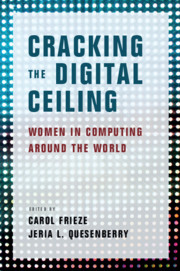Book contents
- Cracking the Digital Ceiling
- Cracking the Digital Ceiling
- Copyright page
- Contents
- Contributors
- Acknowledgments
- Introduction
- Part I Global Perspectives
- Part II Regional Perspectives
- Part III Cultural Perspectives from the United States and Europe
- Part IV Cultural Perspectives from Asia-Pacific
- 14 More Chinese Women Are Needed to Hold Up Half the Computing Sky
- 15 How the Perception of Young Malaysians toward Science and Mathematics Influences Their Decision to Study Computer Science
- 16 Women as Software Engineers in Indian Tamil Cinema
- 17 Women in Computing Education
- 18 Challenging Attitudes and Disrupting Stereotypes of Gender and Computing in Australia
- Conclusion
- Notes
- Index
- References
18 - Challenging Attitudes and Disrupting Stereotypes of Gender and Computing in Australia
Are We Doing It Right?
from Part IV - Cultural Perspectives from Asia-Pacific
Published online by Cambridge University Press: 10 October 2019
- Cracking the Digital Ceiling
- Cracking the Digital Ceiling
- Copyright page
- Contents
- Contributors
- Acknowledgments
- Introduction
- Part I Global Perspectives
- Part II Regional Perspectives
- Part III Cultural Perspectives from the United States and Europe
- Part IV Cultural Perspectives from Asia-Pacific
- 14 More Chinese Women Are Needed to Hold Up Half the Computing Sky
- 15 How the Perception of Young Malaysians toward Science and Mathematics Influences Their Decision to Study Computer Science
- 16 Women as Software Engineers in Indian Tamil Cinema
- 17 Women in Computing Education
- 18 Challenging Attitudes and Disrupting Stereotypes of Gender and Computing in Australia
- Conclusion
- Notes
- Index
- References
Summary
This chapter will provide a current perspective of the gendered nature of computing in Australia. The underrepresentation of women is the most visible issue in this discipline, and may well be a product of the unique culture of the country that is at odds with the multicultural nature of the population. Many initiatives and interventions have been and still are in operation to encourage girls to consider a computing career. However, the proportional numbers of males and females in the discipline in universities and the workforce remains a concern in 2018.
Information
- Type
- Chapter
- Information
- Cracking the Digital CeilingWomen in Computing around the World, pp. 311 - 323Publisher: Cambridge University PressPrint publication year: 2019
